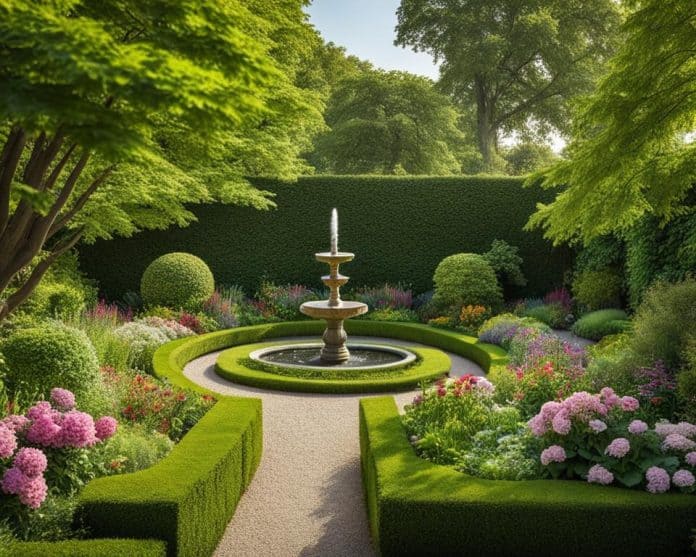
At the heart of any property’s allure lies the potential of its outdoor spaces. Embracing professional landscape design is key to unlocking this potential, transforming the ordinary into the extraordinary. Whether it’s for a cozy home or a bustling commercial establishment, a tailored approach in residential landscaping or commercial landscaping not only boosts curb appeal but also potentially increases property value. It’s a strategic enhancement that marries aesthetics with functionality, creating environments that invite and inspire.
Professional landscape designers serve as the architects of your outdoor sanctuary, aligning their expertise with your vision to cultivate spaces that resonate with individual preferences or business brand values. Through their creative prowess and informed choices, they lay down a roadmap to curb appeal improvement that incorporates current trends, lifestyle considerations, and a deep understanding of spatial dynamics.
Key Takeaways
- The pivotal role professional landscape design plays in enhancing the aesthetic and functional aspects of properties.
- How quality residential and commercial landscaping can elevate a property’s curb appeal and its market value.
- The significance of a tailored approach in landscape design to suit individual tastes and business needs.
- The importance of having an expert landscape designer to guide the transformation of your outdoor space.
- An understanding of current trends in outdoor space enhancement that integrates personal or brand identity.
Understanding the Fundamentals of Landscape Design
The journey to transforming your outdoor area into a harmonious sanctuary begins with grasping the garden design basics and core landscape design principles. By tuning into the intrinsic values of balance, contrast, proportion, unity, and rhythm, you can create spaces that not only capture the eye but also embody functionality and beauty. Let’s delve into these pillars of design and how they shape our interaction with the natural world.
Balance, in landscape design, provides a sense of stability and symmetry, while contrast spices up the garden by introducing variety through colors, textures, and forms. The element of proportion ensures that the scale of different features relates harmoniously to each other. Unity is achieved by repeating some elements or colors to create a cohesive composition, and rhythm directs the movement of the eye through patterns and arrangements. Integrating these principles is essential for a well-rounded outdoor aesthetic.
Before you plant your first shrub or lay a single stone, as any great landscape designer will tell you, landscape planning is crucial. Conducting a thorough site analysis not only illuminates the many strengths and weaknesses of your space but also provides invaluable information necessary for tailoring your landscape vision to your specific environment. This groundwork steers clear planning away from potential pitfalls that could disrupt the balance between design and nature.
- Assessing sun exposure throughout the day
- Evaluating soil type and drainage properties
- Understanding prevailing winds and climate conditions
- Noting existing vegetation and structures
There is a wide spectrum of garden design styles to select from, each capable of narrating a unique story of your space. Whether it is the structured formality of a French garden or the wild, naturalistic approach of an English cottage garden, these styles offer varying contributions to the elements of landscape design. The challenge is in choosing a design that resonates with your aesthetic preferences while satisfying practical requirements.
Landscape design, steeped in functionality, extends beyond pure ornamentation. Through strategic design, it supports environmental sustainability, creates habitats for local wildlife, and brings forth outdoor spaces that are not just seen but also experienced. This functional beauty is at the heart of the design, ensuring that your garden serves as a retreat for relaxation, entertainment, and rejuvenation.
By embracing these foundational principles of landscape design, you embrace the opportunity to craft a space that is uniquely yours—a peaceful, engaging retreat that is thoughtfully planned, balanced between form and function, and resolutely beautiful.
Incorporating Nature: The Impact of Landscape Design on Your Wellbeing
The inherent bond between humans and nature has long been a source of intrigue and inspiration, shaping the spaces we inhabit. Landscape design, when thoughtfully executed, is more than a mere cosmetic upgrade—it’s a vital component to fostering our mental health and physical wellness. As an outdoor sanctuary becomes an extension of one’s living environment, elements such as therapeutic gardens play an influential role in nurturing the soul and healing the mind.
The Connection Between Green Spaces and Mental Health
Empirical research advocating the therapeutic qualities of green spaces has burgeoned, revealing that landscapes rich in floral and arboreal splendor are far from being just aesthetically pleasing—they are a panacea for the urban mind. Mental health finds a robust ally in the lush expanses of nature; where stress dissipates and cognitive function blooms amid the verdant calm.
How Outdoor Aesthetics Influence Physical Wellness
It’s not just the mind that reaps benefits from nature’s bounty. Physical wellness in landscape design is a tangible reality. The spellbinding influence of a well-curated garden, with its myriad hues, textures, and proportions, carries the power to quicken the pulse or soothe the senses, ushering an individual into a state of deep relaxation and recuperation.
Creating a Sanctuary: The Role of Landscape in Personal Refuge
Privacy, serenity, and the comfort of personal space are integral to the conception of an outdoor sanctuary. A place where the day’s troubles are left at the garden gate, therapeutic gardens are tailored sanctuaries that kindle restoration and respite, cradling the individual in an embrace of flora and fauna.
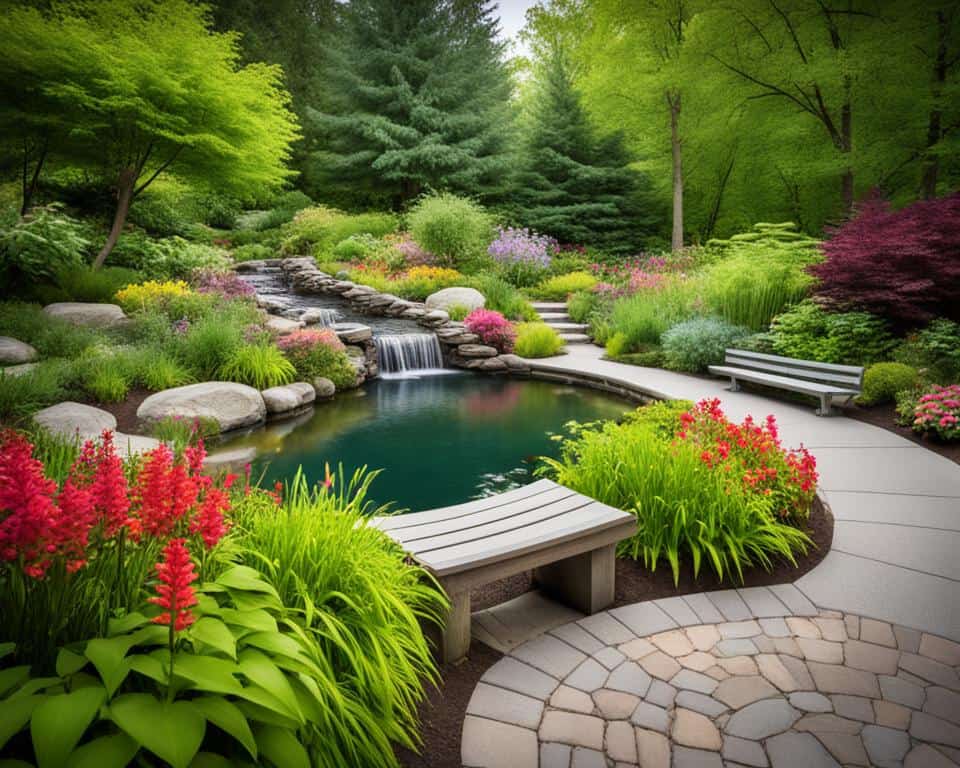
When designing one’s own garden sanctuary, emphasis is often placed on creating multi-sensory experiences that cater to wellbeing. The ambient sound of rustling leaves or a gentle stream, the soft touch of moss, the fragrant perfume of flowers, and the tranquil sight of a harmonious landscape all contribute to a holistic experience that transcends the visual dimension.
To bring these sensory elements to life, here is an illustrative table highlighting the components of a therapeutic garden:
| Element | Benefit | Example |
|---|---|---|
| Aromatic Plants | Stimulate the olfactory system, promoting calmness | Lavender, Rosemary |
| Water Features | Provide soothing sounds and visual appeal | Fountains, Ponds |
| Textured Pathways | Offer tactile stimulation | Pebbled Mosaics, Grass-lined Walkways |
| Varied Flora | Encourage biodiversity and visual stimulation | Native Shrubs, Flowering Perennials |
In view of these insights, it’s clear that landscape design intertwines deeply with our well-being, providing a rich tapestry against which our lives unfurl. By embedding nature’s restorative properties into our everyday spaces, we cultivate a sustaining environment that bolsters our mental health and envelopes us in the embrace of physical wellness.
Landscape Design for Homes: Personalizing Your Outdoor Space
Creating a custom home landscape is an artful endeavor that marries functionality with personal style. It’s about more than just selecting plants and hardscape materials; it’s about shaping your outdoor space to reflect your lifestyle, tastes, and the aesthetic of your home’s architecture. Garden personalization and the integration of water features in landscape designs have become hallmarks of modern outdoor living, offering serene retreats and entertainment-ready spaces alike.
Matching Landscape Designs to Architectural Styles
The architectural garden design should seamlessly extend the personality of your home into the outdoor space. Whether your abode is a stately Colonial, a sleek Modernist masterpiece, or has the charming features of a Craftsman, the landscape can serve as a natural extension of the built environment, reaffirming the design language of your property.
Private Gardens: Making the Most of Your Personal Eden
Garden personalization is akin to curating an exhibit that captures your essence. From vibrant floral arrangements to tranquil green canvases, a garden is a testament to an individual’s connection with nature. It is about crafting your own Eden, where every path and plant tells a part of your personal story.
Innovative Features for Home Landscape: Water Elements and More
Water features in landscape designs offer a tranquil respite from the bustle of daily life. Ponds, fountains, and waterfalls are not just visually captivating; they are the heartbeat of a garden, bringing movement, sound, and a cooling effect to your personal oasis. Including such elements can increase the sensory appeal of your space and even boost its ecological value.
- Architectural Harmony: Select landscaping elements that complement the architectural lines and materials of your home.
- Color Coordination: Use plantings that echo your home’s color scheme to create a unified appearance.
- Personal Touches: Introduce outdoor art pieces, bespoke garden structures, or heirloom plant varieties to inject personality into your garden space.
| Feature | Benefits | Considerations |
|---|---|---|
| Customized Plant Selection | Reflects personal style and fits with the regional climate. | Choose plants that match gardening commitment and maintenance preferences. |
| Water Features | Adds ambiance, aesthetic appeal, and can attract wildlife. | Consider the scale of water features and ongoing maintenance needs. |
| Outdoor Living Areas | Extends living space, perfect for entertainment and relaxation. | Design for accessibility and comfort, taking into account privacy and weather protection. |
Embracing custom home landscaping allows for full expression of individuality while enhancing the functionality and aesthetic of your environment. With thoughtful garden personalization and the inclusion of features like water elements, your outdoor space becomes more than just an area outside your home—it becomes a destination.
Commercial Landscape Design: Enhancing Business Environments
Today’s corporate landscape design goes beyond mere aesthetics; it plays a crucial role in portraying a company’s brand image and ethos. Through meticulously crafted landscapes, businesses can create a powerful initial impression, improving business curb appeal while also providing beneficial spaces for employees and clients alike. Let’s delve into how the integration of strategic plantings, functional outdoor layouts, and sustainable practices can transform a corporate exterior into a captivating and conscientious space.
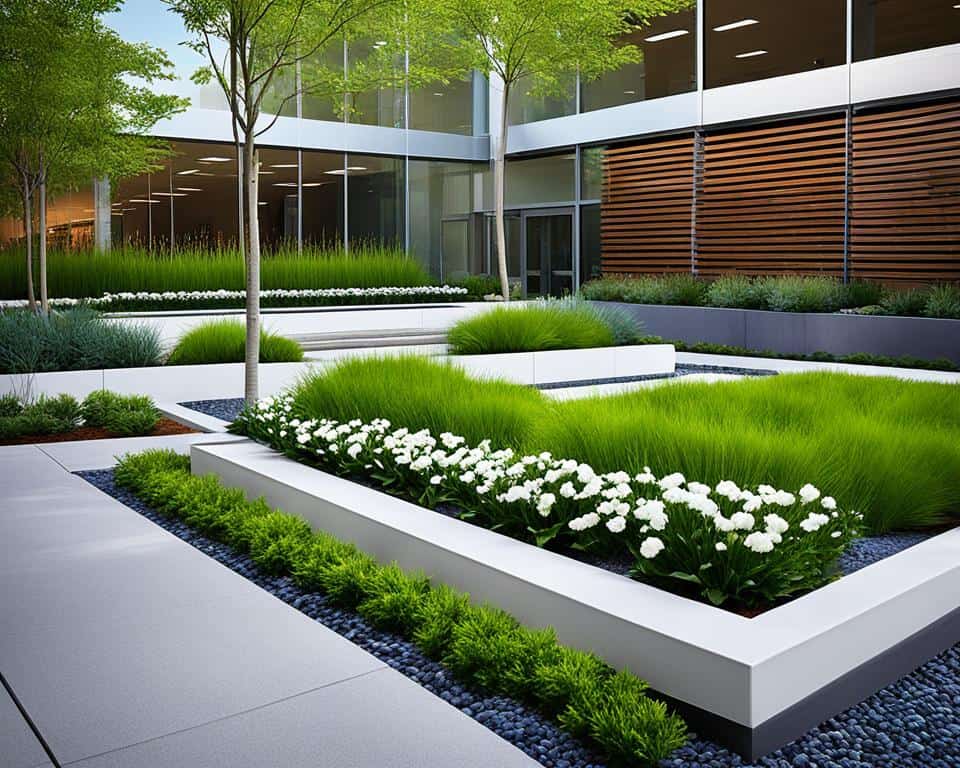
Boosting Business Appeal with Strategic Plantings
Strategic plantings are more than decorative; they have the power to attract potential clients, guiding them through a verdant journey to your doors. Incorporating corporate landscape design principles can communicate stability, growth, and natural harmony, aligning with a company’s vision and values. Seasonal color rotations and landscaping themes specific to a brand can significantly uplift the overall business curb appeal.
Creating Functional Outdoor Spaces for Employees and Clients
Not just a feast for the eyes, well-designed landscapes proffer functional landscaping spaces serving as extensions to the traditional workplace. Al fresco dining areas, serene nooks for breaks, and even outdoor conference spots can greatly enhance employee satisfaction and client experience. It’s about designing for utility and pleasure, catering to both rest and recreation, within a professional setting.
Sustainable Landscaping Solutions for Businesses
Incorporating sustainable business gardens into your corporate landscape not only supports environmental stewardship but also casts a forward-thinking light on your business profile. Techniques like rainwater harvesting, the use of native plants, and renewable material choices all contribute to an eco-friendly footprint, speaking volumes about a company’s dedication to the bigger picture.
| Feature | Business Benefit | Environmental Impact |
|---|---|---|
| Xeriscaping | Reduces water usage and costs | Conserves water and adapts to local climate |
| Native Plants | Requires less maintenance, resonates with local clientele | Provides habitat for local wildlife, reduces chemical use |
| Solar Lighting | Enhances security with low operating costs | Reduces carbon footprint, promotes renewable energy |
| Green Roofs or Walls | Improves building insulation, offers unique branding element | Improves air quality, increases biodiversity |
Year-Round Landscape Design Strategies
As the seasons shift, so does the canvas of your garden. A keen eye for seasonal landscaping is essential when you’re aiming to captivate the senses throughout the year. Including evergreen planting into your vision caters not only to the aesthetic but also to the practical, laying the groundwork for an all-weather garden design that radiates charm in the heat of July or the frost of January.
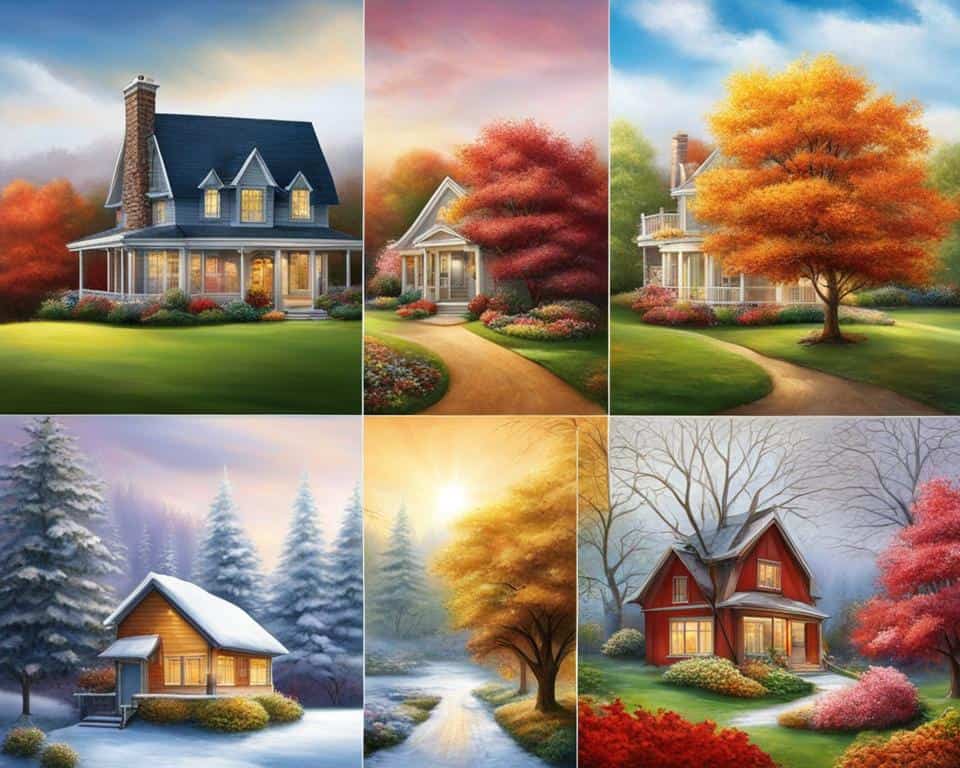
Incorporating a four-season landscape planning approach requires not just knowledge of your climate zone but also an appreciation for the temporal. It’s about creating harmony between your outdoor space and the dynamic rhythms of nature. Here are several strategies to ensure that your garden offers an ever-appealing sanctuary, regardless of the season:
- Selecting Plants for Continuous Bloom: Cycle through the color palette with a thoughtful selection of plants that bloom at different times. This ensures that as one plant’s flowers fade, another’s blossom.
- Structural Planting: Use trees and shrubs to give your yard shape and form. These elements act as the bones of your garden, providing structure even when flowers have retreated.
- Evergreens: The backbone of the winter garden, evergreens keep your outdoor space looking lush and vibrant when other plants are dormant.
- Adaptive Features: From pervious pavers that prevent waterlogging during rain to sturdy gazebo structures that withstand snow, including adaptable hardscape elements is key.
Planning your garden’s layout with these strategies in mind ensures an enchanting setting all year round, boosting not just the visual appeal but also the functionality of your living space. Embrace the change of seasons with a landscape that adapts, perseveres, and thrives, come rain, wind, or snow.
Landscape Design for Your House or Business: A Transformational Approach
Embarking on a landscape design transformation begins with a holistic understanding of the space you’re working with. Whether you’re considering subtle enhancements for your new home or a major overhaul for a business property, every successful landscape project starts with a detailed landscape assessment. This not only ensures that essential design elements are thoughtfully integrated but also sets the stage for a partnership with landscape professionals that is rooted in clarity and vision.
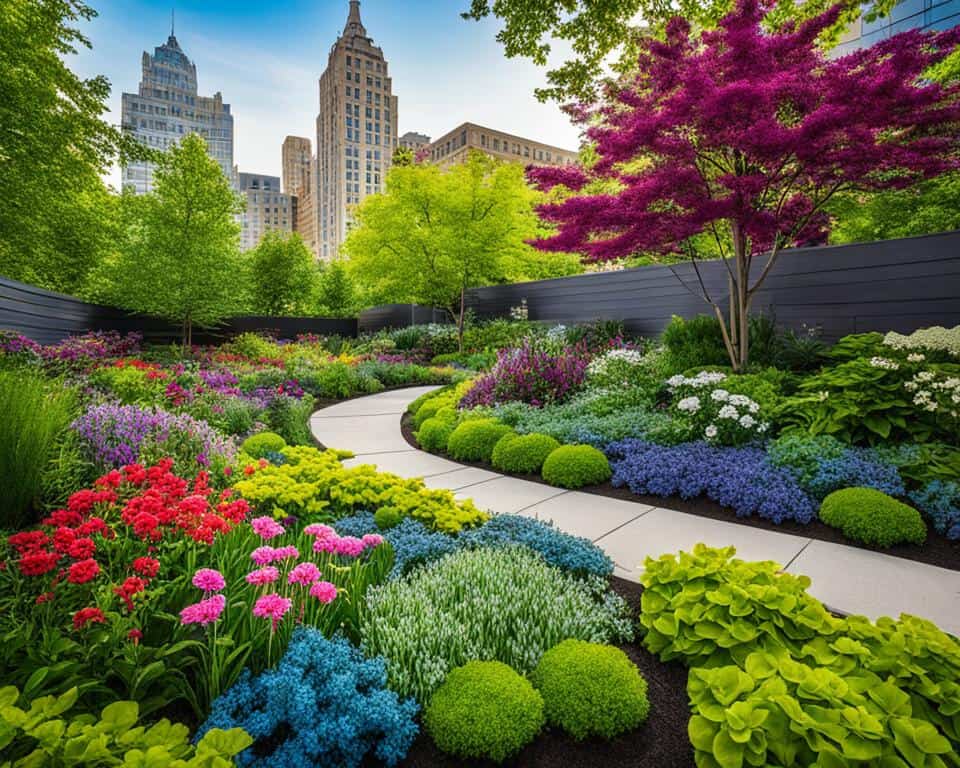
Assessing Your Space: Starting the Landscape Design Process
To initiate the process of reinventing your outdoor space, a comprehensive assessment is crucial. Evaluating factors such as sunlight exposure, soil quality, and existing plant life will provide valuable insight. This phase is not just about noting what is present, but also understanding the full potential of your landscape. By analyzing your space’s strengths and existing issues, a tailored plan can be developed that aligns with your preferences and the landscape’s intrinsic qualities.
Design Elements That Elevate Both Residential and Commercial Properties
Incorporating essential design elements such as focal points and articulated walkways can significantly elevate the aesthetic of both residential and commercial properties. Equally important are water features that serve as calming centerpieces, infusing tranquility into daily life. Moreover, these features aren’t just visually appealing; they’re functional components that enhance the usability of any landscape, encouraging movement, interaction, and a deeper connection with the natural environment.
Working with Professional Landscape Designers: What to Expect
When hiring landscape professionals, expect to engage in a collaborative process that brings together expertise and personal vision. The right team will guide you through design options, material selections, and craft a plan that respects both your budget and timeline. From initial design concepts to the final touches of planting, professional designers will ensure that your landscape transformation is both beautiful and sustainable over the long term.
- Understand your project goals and desired outcomes
- Communicate openly about design preferences and practical needs
- Respect for your time, property, and investment throughout the project
With thoughtful planning, a creative approach to essential design elements, and the expertise of experienced landscape professionals, a well-executed landscape design can spectacularly transform any property, infusing it with renewed vibrancy and appeal.
Native Plants and Eco-friendly Landscape Practices
Embracing native plant landscaping and eco-friendly gardening is more than a trend; it’s a commitment to fostering a sustainable ecosystem design. By integrating plants that are indigenous to the area, gardeners and landscapers can establish water-wise landscaping strategies that contribute positively to the surrounding environment.
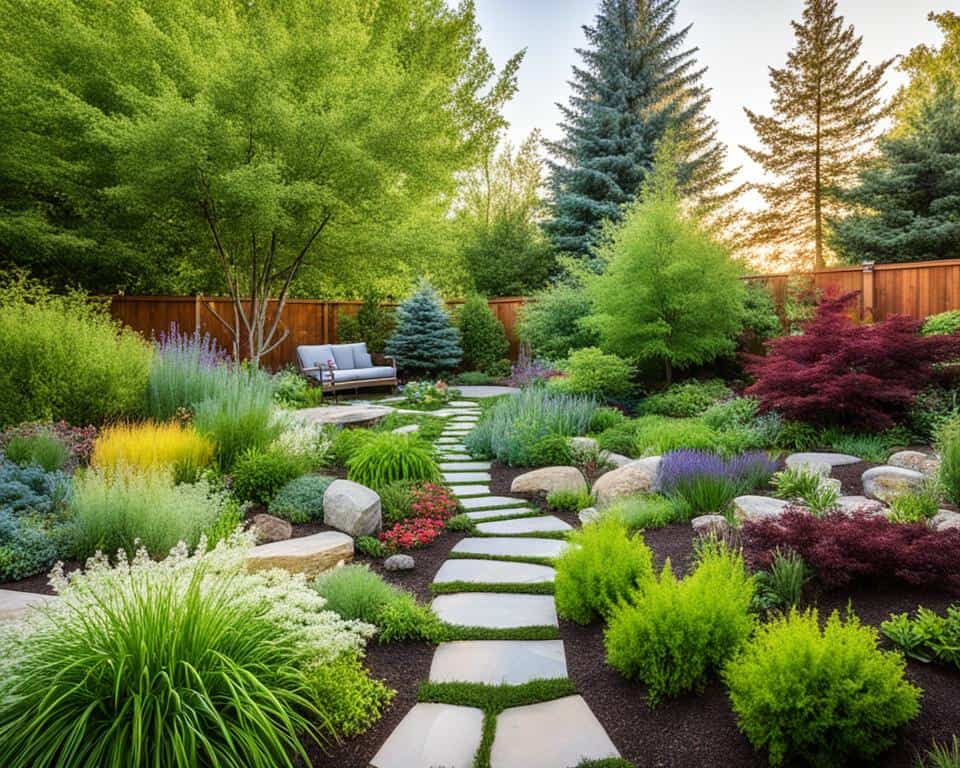
The Benefits of Using Native Plants in Your Landscape
Choosing native plants for your garden not only enhances the aesthetic appeal but also significantly cuts down on maintenance. These species have evolved to thrive in specific local conditions, making them incredibly resilient to climatic stresses that non-native plants might succumb to. They form a symbiotic relationship with local wildlife, offering habitats and food sources, which is vital for preserving and supporting the biodiversity in your community.
Water Conservation and Sustainable Landscape Techniques
At the heart of eco-friendly gardening lies the practice of water conservation. Implementing a water-wise landscaping strategy involves selecting drought-tolerant plant species and employing efficient irrigation systems. Mulching and proper soil preparation further ensure that water is conserved within the landscape, reducing the need for frequent watering and contributing to a more sustainable garden environment.
Contributing to Local Ecology through Thoughtful Landscape Design
Every choice in landscape design can significantly impact the local ecosystem. By choosing sustainable ecosystem designs, you are making a conscious decision to promote a healthy, balanced environment. This encourages an increase in local fauna, which contributes to pollination and the growth of a biodiverse habitat. Through thoughtful plant selection and placement, your garden can become an ethical space that respects and enlivens the natural world around it.
Outdoor Lighting and Accessories in Landscape Design
Enhancing your outdoor space goes beyond choosing the right plants and hardscape; landscape illumination plays a pivotal role in creating an inviting atmosphere while ensuring safety after dark. By integrating garden lighting into your landscape design, you provide a dual function of security and aesthetic appeal, lighting up pathways and accentuating key features of your garden.
When selecting lighting fixtures, it’s important to consider both the style and the function they will serve. Outdoor décor isn’t just about beauty; it’s about creating a cohesive look that complements your overall landscape design. Consider the use of spotlights to highlight trees and architectural details, or soft pathway lights for gentle illumination that guides your steps.
The choice of landscape accessories can personalize your outdoor space, reflecting your style and tastes. Functional yet decorative items like bird baths and wind chimes add character while supporting local wildlife. Here are some ideas to enhance your outdoor environment:
- Strategically placed LED lights for energy efficiency
- Solar-powered lanterns for eco-friendly lighting
- Durable metallic or stone sculptures as focal points
Attention to trends is crucial for keeping your garden’s look contemporary. Smart technology now allows homeowners to control lighting remotely, change colors, and even integrate outdoor lighting systems with home assistants for automation and energy conservation.
Remember, your outdoor space is an extension of your home. Proper lighting and thoughtfully chosen accessories can transform it into a stunning landscape that invites you to linger outdoors, long after the sun has set.
Crafting a Low-Maintenance Landscape for Busy Individuals
The contemporary pace of life often leaves little time for garden upkeep, which is why low-maintenance landscaping is increasingly sought after. Achieving an easy-care garden that also exudes aesthetic charm is fully attainable with smart planning and the right components. Convenience does not have to sacrifice beauty, especially when you harness the benefits of automated garden systems and durable landscape design.
Choosing Plants That Thrive with Minimal Care
Selecting the right plants is fundamental for creating an easy-care garden. Opt for species that are drought-resistant, perennial, and native to your region. These plants require less water, adapt better to local climate conditions, and are more resistant to pests and diseases. By doing so, your landscape transforms into a sustainable space teeming with natural beauty that demands minimal intervention.
Implementing Automated Systems for Lawn and Garden Maintenance
To further minimize the time spent on garden care, consider the implementation of cutting-edge automated garden systems. Technologies such as drip irrigation and robotic mowers keep your garden flourishing without ongoing manual effort. An automated, efficient irrigation system ensures plants receive the precise amount of water at the right time, while robotic mowers can keep lawns perfectly trimmed with little to no human oversight.
Designing with Durability and Ease in Mind
Durable landscape design is not just about choosing robust plant species; it’s also about incorporating materials and features that can endure the elements and time. Opt for hardscape elements like stone patios or composite decking which are weather resistant and require minimal maintenance. Strategic placement of these elements can also reduce the area of lawn that requires mowing, contributing to a comprehensive low-maintenance outdoor environment.
| Plant Type | Features | Care Level |
|---|---|---|
| Perennial Grasses | Hardy, drought-resistant, minimal pruning | Low |
| Native Shrubs | Adapted to local conditions, supports wildlife | Low |
| Succulents | Retain water, thrive in arid conditions | Very Low |
| Evergreens | Year-round foliage, infrequent trimming | Low |
Conclusion
As we draw our journey of landscape design exploration to a close, we reflect on the myriad ways that thoughtfully crafted outdoor spaces enrich our lives. From the peaceful retreat of a private garden to the dynamic allure of a corporate landscape, the power of design lies in its ability to transform not only our surroundings but also our experiences within them. The fusion of aesthetic beauty with functional use in landscape design is not merely an art form; it is an essential investment in the quality of our daily living and the impression we impart on others, be it in residential tranquility or commercial vitality.
Summarizing the Key Takeaways on Landscape Design
Throughout this article, we’ve delved into the significance of professional landscape design, emphasizing its role in enhancing outdoor areas and, by extension, our mental and physical well-being. We’ve uncovered the importance of harmonizing the landscape with the identity of our homes and businesses, utilizing eco-friendly practices, and reveling in the year-round splendor of our outdoor environments. A comprehensive landscape design summary not only conveys the essence of transforming spaces but also stands as a testament to the lasting benefits these enhancements bring.
Next Steps to Elevate Your Space with Professional Landscape
If you’re ready to embark on the rewarding journey of landscape project commencement, consider this a call to action. Arm yourself with professional landscaping tips garnered here, and seek the expertise of skilled landscape designers to translate your vision into reality. It’s through their insight and creativity that your aspirations for enhancing outdoor areas can bloom into an extraordinary and sustainable affinity with nature. Begin this transformative process today, and witness the unfolding of an environment that resonates with charm, efficiency, and life-affirming vigor.
FAQ
How can professional landscape design enhance the outdoor space of my home or business?
Professional landscape design plays a crucial role in not only enhancing the aesthetic appeal of your property but also improving its functionality. Quality landscaping can significantly boost curb appeal, potentially increasing property value, and ensuring your outdoor space aligns with your personal or brand identity.
What are the core principles that drive landscape design?
The core principles of landscape design include balance, contrast, proportion, unity, and rhythm. Understanding and applying these principles are essential in creating a landscape that is harmonious, visually appealing, and enhances the overall aesthetic of the space.
Can landscape design have a positive impact on my wellbeing?
Absolutely! Scientific studies have highlighted a strong correlation between green spaces and improved mental health. A well-designed landscape with aesthetic elements like color, texture, and scale can promote physical wellness and provide a sanctuary for relaxation and stress relief.
How can I personalize my home’s landscape design to match its architectural style?
Personalizing your home’s landscape involves choosing designs and elements that complement your home’s architectural style. This creates a cohesive look and feel. Professional landscape designers can help you select the right plantings, features, and layouts that reflect your taste while enhancing your home’s charm.
What are some benefits of commercial landscape design?
As well as space decor, a good commercial landscape design can significantly enhance a business’s curb appeal, attract customers, and provide pleasant outdoor spaces for employees and clients. Incorporating sustainable practices such as xeriscaping can also reduce environmental impact and operation costs, while fostering a positive brand image.
How do I ensure my garden is visually appealing year-round?
To achieve a garden that remains attractive across all seasons, consider incorporating plants that offer year-round interest, such as evergreens or seasonal bloomers. Utilizing hardscape elements and seasonal decorations can also help maintain your garden’s appeal during less vibrant months.
What should I expect when working with a professional landscape designer?
When collaborating with a professional landscape designer, you can expect personalized advice on how to best utilize your outdoor space, tailored design plans, and guidance through every stage of the process – from the initial concept to the final implementation of the landscape design.
Why are native plants recommended for eco-friendly landscaping?
Native plants are recommended because they are adapted to your local climate and often require less maintenance. They support local wildlife and contribute to the biodiversity and health of local ecosystems, which is integral to eco-friendly and sustainable landscape practices.
How can I implement outdoor lighting in my landscape design?
Outdoor lighting can be incorporated to enhance safety, create ambiance, and draw attention to key features of your landscape. Choosing the right type of fixtures and placing them strategically around pathways, foliage, and architectural features can significantly improve your landscape’s nighttime appeal.
What are some considerations for creating a low-maintenance landscape?
For a low-maintenance landscape, select plant species known for their resilience and minimal care requirements. Incorporate automated systems for watering and lawn maintenance, and choose durable materials. Design for ease of maintenance without sacrificing the beauty of your outdoor space.











































